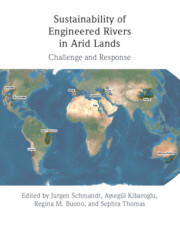Book contents
- Sustainability of Engineered Rivers in Arid Lands
- Sustainability of Engineered Rivers in Arid Lands
- Copyright page
- Dedication
- Contents
- Contributors
- Part I Introduction
- Part II Challenge
- 2 Global Climate Change and the Rivers
- 3 Reservoirs
- 4 Depletion of Groundwater
- 5 Endangered Food Security
- 6 Declining Environmental Flows
- Part III Engineered Rivers
- Part IV Response
- Part V Conclusion
- Index
- References
5 - Endangered Food Security
from Part II - Challenge
Published online by Cambridge University Press: 16 September 2021
- Sustainability of Engineered Rivers in Arid Lands
- Sustainability of Engineered Rivers in Arid Lands
- Copyright page
- Dedication
- Contents
- Contributors
- Part I Introduction
- Part II Challenge
- 2 Global Climate Change and the Rivers
- 3 Reservoirs
- 4 Depletion of Groundwater
- 5 Endangered Food Security
- 6 Declining Environmental Flows
- Part III Engineered Rivers
- Part IV Response
- Part V Conclusion
- Index
- References
Summary
Agriculture, as the primary user of the world’s water resources, bears great promise in coping with water scarcity. Agriculture’s sub-sectors, such as plant production, livestock, and aquaculture, can significantly improve their practices that can lead to water savings, conservation of natural resources, climate change benefits, and co-benefits and can still increase levels of productivity and production to cater for a growing population. Accomplishing this requires a major change in the way we manage our water, land, and soil resources. We underline the key benefits of holistic approaches such as IWRM, nexus, and integrated landscape management, and provide examples from replicable practices.
Keywords
- Type
- Chapter
- Information
- Sustainability of Engineered Rivers In Arid LandsChallenge and Response, pp. 57 - 65Publisher: Cambridge University PressPrint publication year: 2021



